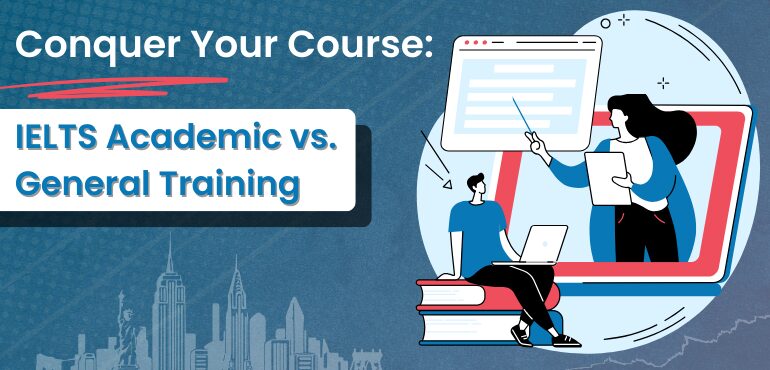
The dream of studying abroad for Indian students can be a powerful motivator. It represents a chance to expand horizons, pursue academic excellence, and embark on a transformative journey filled with personal growth and exciting career opportunities. However, before embarking on this exciting adventure, there’s one crucial hurdle to overcome: demonstrating English language proficiency.
Here’s where the International English Language Testing System (IELTS) comes in. Accepted by universities worldwide, IELTS is a standardized test designed to assess the English skills of non-native speakers. However, with two test formats – Academic and General Training – choosing the right one can be confusing. This article will break down the key differences between the IELTS Academic and General Training tests, helping you select the most suitable option for your study abroad aspirations.
Understanding the Purpose
The primary distinction between the two formats lies in their intended purpose. The IELTS Academic test is specifically designed for students applying to undergraduate or postgraduate programs where English is the primary language of instruction. It assesses your ability to handle the demands of academic life, including understanding complex lectures, critically analyzing written materials, and expressing yourself clearly in an academic setting.
On the other hand, the IELTS General Training test caters to individuals seeking migration or work opportunities in English-speaking countries. It focuses on assessing your ability to communicate effectively in everyday situations, which is another key aspect of the overall IELTS overview. This may include tasks like completing application forms, understanding workplace instructions, or engaging in social interactions.
Test Format Breakdown
Both IELTS formats consist of four core sections: Listening, Reading, Writing, and Speaking. Each section is designed to evaluate your proficiency in a specific domain of English communication. Here’s a closer look at the differences in these sections:
Listening
Both tests utilize similar audio recordings featuring conversations and monologues in various accents. However, the Academic test content leans towards academic lectures and seminars, while the General Training test focuses on everyday situations like workplace discussions or public announcements.
Reading
The Academic test presents three lengthy passages on complex academic topics from various disciplines. You’ll be expected to analyze information, identify arguments, and demonstrate comprehension through different question types. The General Training test features a wider range of texts, including informational brochures, advertisements, and short factual passages reflecting real-world scenarios.
Writing
The writing section also reflects the test’s purpose. The Academic test requires you to analyze data or information presented in a chart, graph, or diagram (Task 1) and write an essay that analyzes, argues, or evaluates a specific topic (Task 2). The General Training test tasks involve writing a personal letter requesting information or applying for something (Task 1) and expressing an opinion, or writing a persuasive letter (Task 2).
Speaking
This section remains the same for both formats. You’ll engage in a face-to-face conversation with an examiner, starting with introductory questions and progressing to discussions about familiar topics and hypothetical situations. The Speaking test assesses your fluency, grammar accuracy, vocabulary range, and ability to communicate effectively.
Choosing the Right Test
Knowing the key differences should help you make an informed decision. Here are some additional factors to consider:
- University Requirements: Most universities have specific English language proficiency requirements. Check your desired program’s website to determine whether they mandate IELTS Academic or accept either format.
- Your Study Goals: If you’re aiming for an undergraduate or postgraduate degree in an English-speaking country, the IELTS Academic test is the clear choice.
- Your Strengths and Weaknesses: Consider your current English language skills and preferred communication style. If you feel more comfortable with academic topics and analysis, the Academic test might suit you better.
Preparing for the Test
Once you’ve chosen the appropriate format, dedicate time to thorough preparation. Utilize official IELTS resources, practice tests, and study materials designed specifically for your chosen format.
Conclusion
By understanding the distinct features of the IELTS Academic and General Training tests, you can confidently select the one that aligns with your study abroad aspirations. With dedicated preparation and a strategic approach, you can ace your chosen IELTS test and unlock the door to exciting academic and professional opportunities. So, dream big, prepare diligently, and conquer the IELTS!








